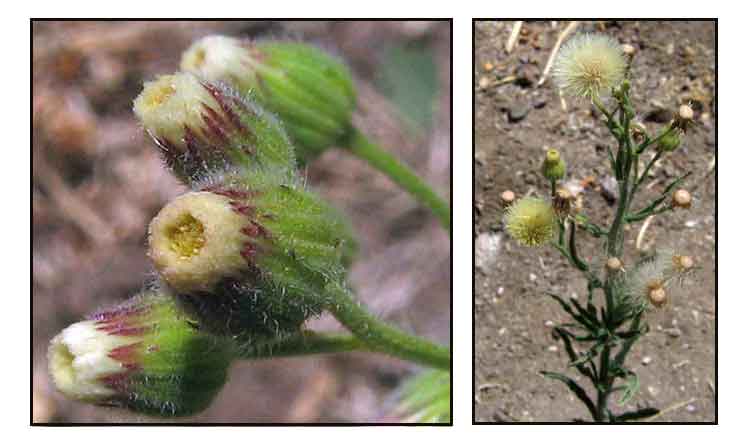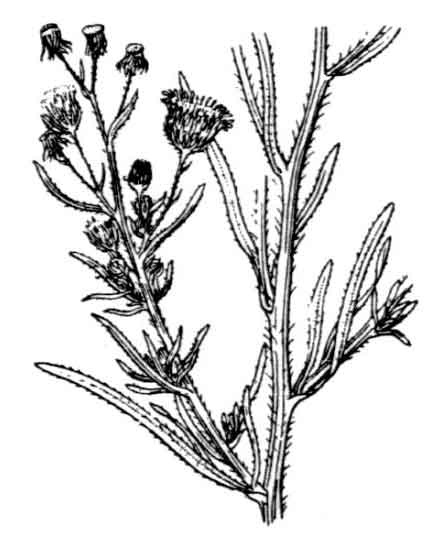
Family • Compositae
Tagabili
Erigeron bonariensis L.
HAIRY FLEABANE
Ye tang hao
| Scientific names | Common names |
| Aster ambiguus (DC.) E.H.Krause | Asipukpuk (Pang.) |
| Conyza ambigua DC. | Atipukpuk (Ilk.) |
| Conyza bonariensis (L.) Cronquist | Balagun (Bag.) |
| Conyza chenopodioides DC. | Batbatung (Bon.) |
| Conyza crispa (Pourret) Rupr. | Insok (Ilk.) |
| Conyza crispa (Pourr.) Cout. | Lagia (Ilk.) |
| Conyza gracilis Hoffmanns. & Link | Put-putak (Ig.) |
| Conyza hispida Kunth | Tagabili (Bik.) |
| Conyza ivifolia Burm. f. | Takiadauan (Bon.) |
| Conyza leucodasys Miq. | American horseweed (Engl.) |
| Conyza linearis DC. | Asthma weed (Engl.) |
| Conyza plebeha Phil. | Flax-leaf fleabane (Engl.) |
| Conyza rufescens Hoffmanns. & Link | Hairy fleabane (Engl.) |
| Conyza sinuata Elliott | |
| Conyza sordescens Cabrera | |
| Conyzella linifolia (Willd.) Greene | |
| Dimorphanthes ambigua C. Presl | |
| Dimorphanthes angustifolia Cass. | |
| Dimorphanthes crispa Rupr. | |
| Dimorphanthes hispida (Kunth) Cass. | |
| Dimorphanthes linifolia (Willd.) Rupr. | |
| Erigeron ambiguus Sch.Bip. ex Webb & Berthel. | |
| Erigeron bonariensis L. | |
| Erigeron contortus Desf. ex Pers. | |
| Erigeron coranopifolius Willk. & Lange | |
| Erigeron crispus Pourr. | |
| Erigeron gusalakensis Rech.f. & Edelb. | |
| Erigeron linerifolius Cav. | |
| Erigeron linifolius Willd. | |
| Erigeron looseri Herter | |
| Erigeron naudinii (Bonnet) Bonnier | |
| Erigeron transsilvanicus Schur | |
| Erigeron undulatus Moench | |
| Eschenbachia ambigua Moris | |
| Eupatorium dictophyllum DC. | |
| Leptilon bonariense (L.) Small | |
| Leptilon linifolium (Willd.) Small | |
| Marsea bonariensis (L.) V.M.Badillo | |
| Pulcaria gracilis (Hoffmanns. & Link) Nyman | |
| Pulcaria rufescens (Hoffmanns. & Link) Nyman | |
| Erigeron crispus Pourr. is a synonym of Erigeron bonariensis L. The Plant List | |
| Erigeron bonariensis L. is an accepted name. The Plant List | |
| Other vernacular names |
| AFRIKAAN: Kleinskraalhans. |
| ARABIC: Koweenza |
| CHINESE:Ye di huang ju, Suo yi cao, Xiang si cao, Ye tang hao. |
| FRENCH: Erigeron crepu |
| GERMAN: Südamerikanisches Berufskraut |
| INDIA: Buar. |
| ITALIAN: Saeppola di Buenos Aires |
| PAKISTAN: Gulava, Mrich booti. |
| PORTUGUESE: Avoadinha-peluda |
| SPANISH: Joppo de zorra |
Updated August 2019 / December 2016
![]()
 |
| IMAGE SOURCE: (2) Little Horseweed / Erigeron bonariensis / Will Rogers State Historic Park / Research Learning Center / Click on image to go to source page |
| OTHER IMAGE SOURCE: Photohraph / Conyza bonariensis/ Photo taken and uploaded by Iorsh / Public Domain / Wikipedia |
| OTHER IMAGE SOURCE: Illustration / Erigeron bonariensis / Conyza bonariensis (L.) Cronq. (Asthmaweed) Hippolyte Coste - Flore descriptive et illustrée de la France, de la Corse et des contrées limitrophes, 1901-1906 - This image is in public domain because its copyright has expired / alterVISTA |
Additional
Sources and Suggested Readings |
| It is not uncommon for links on studies/sources to change. Copying and pasting the information on the search window or using the DOI (if available) will often redirect to the new link page. (Citing and Using a (DOI) Digital Object Identifier) |
• |
 |



